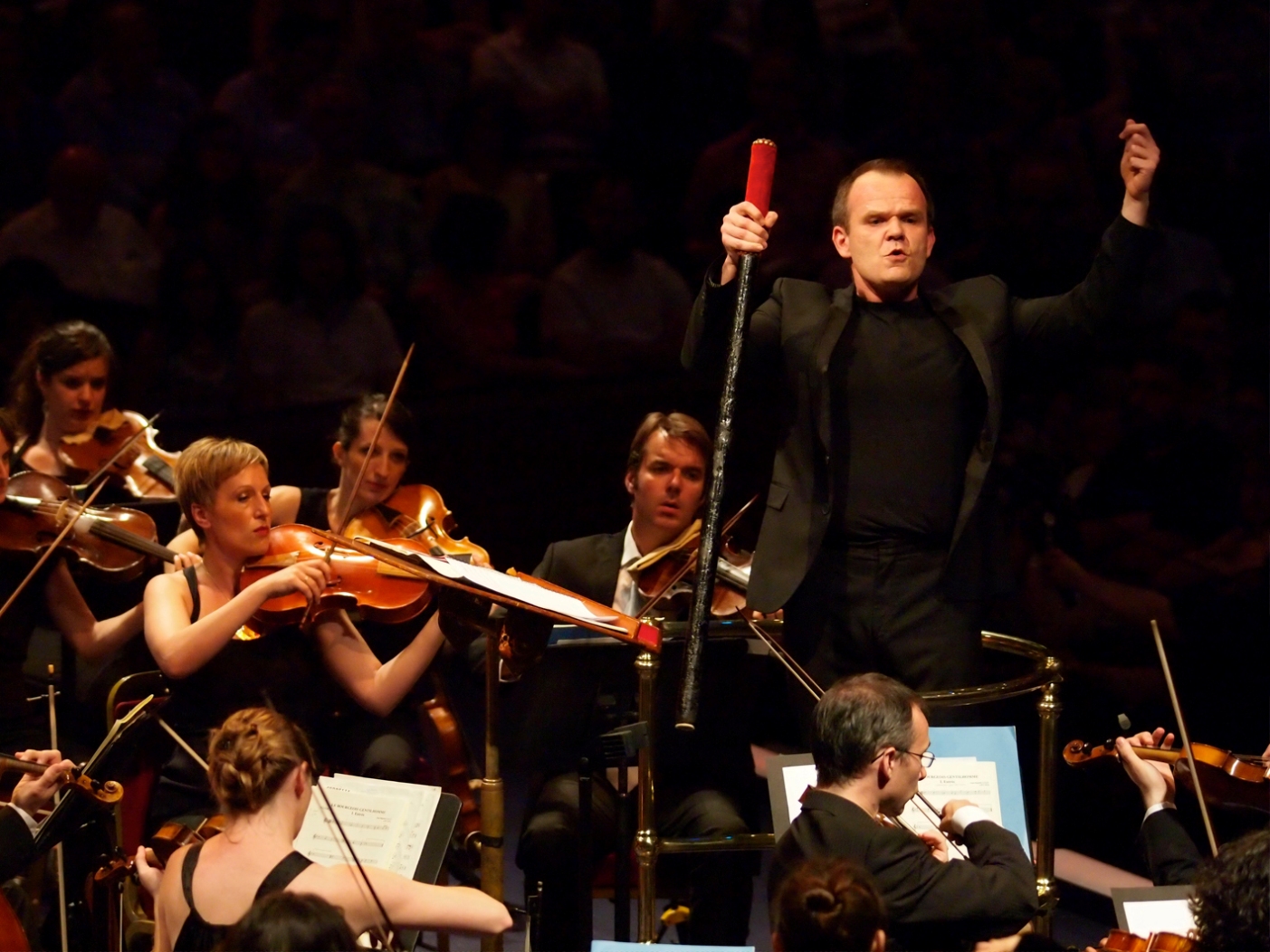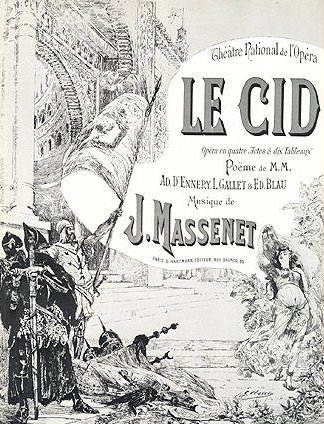Prom 4: Les Siècles, Roth | reviews, news & interviews
Prom 4: Les Siècles, Roth
Prom 4: Les Siècles, Roth
Fresh and light approach to nearly 250 years of ballet music in Paris
You can get away with playing ballet music of the Ancien Régime on Bastille Day so long as you end with a revolution. That was how live wire François-Xavier Roth and his mostly French musicians angled it, covering nearly 250 years of Parisian dance premieres on their way to the Proms centenary performance of Stravinsky’s The Rite of Spring.
There were spectacles few, if any, will have seen at the Proms. Roth beginning proceedings by striking his red-handled staff, in homage to the very pre-baton instrument which struck Lully’s toe in 1687 and killed him from a gangrenous infection (Roth pictured below last night by Sisi Burn). Shaking of a handsome bell tree or Turkish crescent during the two most exotic court dances. Fresh, post-18th century fiddles waiting on stage to take the place of the oldsters. Players turning to salute the bust of Sir Henry Wood and, more specifically, the audience seated either side of the organ.
 Yet there were also the notorious Albert Hall acoustics which flattened, sometimes killed stone dead, Roth’s attempts to bring the gut and bite of the authentic approach (why don't I trust my instincts and head straight down into the Arena, the only place where anything registers properly?). Hearing Lully and Rameau through a gauze came as a special shock only a week after I’d been overwhelmed by the ferocity of the Orchestra of the Age of Enlightenment under William Christie in Glyndebourne’s stunning Hippolyte et Aricie.
Yet there were also the notorious Albert Hall acoustics which flattened, sometimes killed stone dead, Roth’s attempts to bring the gut and bite of the authentic approach (why don't I trust my instincts and head straight down into the Arena, the only place where anything registers properly?). Hearing Lully and Rameau through a gauze came as a special shock only a week after I’d been overwhelmed by the ferocity of the Orchestra of the Age of Enlightenment under William Christie in Glyndebourne’s stunning Hippolyte et Aricie.
No matter; Lully was shaped with as much affection as his formality would allow, and it’s little wonder if Rameau came off as much the more adventurous; after all, there are 65 years between the comedy-ballet Le bourgeois gentilhomme in 1670 and Les Indes galantes in 1735 (as much time as elapsed between Strauss’s Der Rosenkavalier and Britten’s Death in Venice). Still, you wonder if Lully would ever have reached the weird harmonic descents Rameau plumbs in the middle of his Danse du grand Calumet de la paix.
Violins were exchanged, extra players brought on: midway through the first half we moved on to the 19th century and, alas, only half the originally promised quarter-hour of music from Delibes’s Coppélia. Only the whole ballet score will do next time at the Proms. As it was, we got not the Musique des Automates, the doll music which would have continued a sense of le merveilleux originating in Louis XIV’s court, but the ubiquitous waltz and mazurka, both inappropriately automatic and too fast (unless Roth knows something about Delibes’s metronome markings that I don’t).
 There was more playfulness about the Spanish divertissement from Massenet’s Le Cid (original poster for the opera pictured left), but why lop two of the seven equally inventive dances? Anyway, you couldn’t ask for more from Massenet in terms of piquant orchestration and melody. Among many woodwind colourings of pure delight, Stéphane Morvan’s cor anglais solo before the Madrilène's giddying take-off told us that Massenet got there way before Rodrigo in terms of Spanish soulfulness.
There was more playfulness about the Spanish divertissement from Massenet’s Le Cid (original poster for the opera pictured left), but why lop two of the seven equally inventive dances? Anyway, you couldn’t ask for more from Massenet in terms of piquant orchestration and melody. Among many woodwind colourings of pure delight, Stéphane Morvan’s cor anglais solo before the Madrilène's giddying take-off told us that Massenet got there way before Rodrigo in terms of Spanish soulfulness.
Perhaps it was apt in this company that the Les Siècles view of The Rite of Spring was often brisk, bright and snappy. Roth’s promise of more colours in the use of 1913-era brass certainly materialized in the incisive, garish trumpets, less so in the sometimes dodgy horn ensemble. There was no question, though, of the disgrace which the last French visitor to the Proms in this work, the Orchestre National de France under Daniele Gatti, brought upon itself with a disastrous botched entry. Roth had his own ideas about timing of attack and precision of those famous reiterated chords, and everything seemed to work as he wanted it to.
No special novelties struck us for some time after the hideous coughing obbligatos that accompanied the opening pipes; was it Stravinsky’s weaker original scoring or just the lack of string power that failed to bring out one of the many melodies in Part One? You had to wait until the Chosen One had virtually danced herself to death before subtleties struck which the composer must have thought didn’t sound well enough leading up to ultimate collapse. And that, at least, with cymbals and guero or lion’s roar adding their voices to the final chord, was something none of us would have heard before.
rating
Explore topics
Share this article
Add comment
The future of Arts Journalism
You can stop theartsdesk.com closing!
We urgently need financing to survive. Our fundraising drive has thus far raised £49,000 but we need to reach £100,000 or we will be forced to close. Please contribute here: https://gofund.me/c3f6033d
And if you can forward this information to anyone who might assist, we’d be grateful.

Subscribe to theartsdesk.com
Thank you for continuing to read our work on theartsdesk.com. For unlimited access to every article in its entirety, including our archive of more than 15,000 pieces, we're asking for £5 per month or £40 per year. We feel it's a very good deal, and hope you do too.
To take a subscription now simply click here.
And if you're looking for that extra gift for a friend or family member, why not treat them to a theartsdesk.com gift subscription?
more Classical music
 Hallé John Adams festival, Bridgewater Hall / RNCM, Manchester review - standing ovations for today's music
From 1980 to 2025 with the West Coast’s pied piper and his eager following
Hallé John Adams festival, Bridgewater Hall / RNCM, Manchester review - standing ovations for today's music
From 1980 to 2025 with the West Coast’s pied piper and his eager following
 Kaploukhii, Greenwich Chamber Orchestra, Cutts, St James's Piccadilly review - promising young pianist
A robust and assertive Beethoven concerto suggests a player to follow
Kaploukhii, Greenwich Chamber Orchestra, Cutts, St James's Piccadilly review - promising young pianist
A robust and assertive Beethoven concerto suggests a player to follow
 Robin Holloway: Music's Odyssey review - lessons in composition
Broad and idiosyncratic survey of classical music is insightful but slightly indigestible
Robin Holloway: Music's Odyssey review - lessons in composition
Broad and idiosyncratic survey of classical music is insightful but slightly indigestible
 Classical CDs: Wolf-pelts, clowns and social realism
British ballet scores, 19th century cello works and contemporary piano etudes
Classical CDs: Wolf-pelts, clowns and social realism
British ballet scores, 19th century cello works and contemporary piano etudes
 Bizet in 150th anniversary year: rich and rare French offerings from Palazzetto Bru Zane
Specialists in French romantic music unveil a treasure trove both live and on disc
Bizet in 150th anniversary year: rich and rare French offerings from Palazzetto Bru Zane
Specialists in French romantic music unveil a treasure trove both live and on disc
 Scottish Chamber Orchestra, Ibragimova, Queen’s Hall, Edinburgh review - rarities, novelties and drumrolls
A pity the SCO didn't pick a better showcase for a shining guest artist
Scottish Chamber Orchestra, Ibragimova, Queen’s Hall, Edinburgh review - rarities, novelties and drumrolls
A pity the SCO didn't pick a better showcase for a shining guest artist
 Kilsby, Parkes, Sinfonia of London, Wilson, Barbican review - string things zing and sing in expert hands
British masterpieces for strings plus other-worldly tenor and horn - and a muscular rarity
Kilsby, Parkes, Sinfonia of London, Wilson, Barbican review - string things zing and sing in expert hands
British masterpieces for strings plus other-worldly tenor and horn - and a muscular rarity
 From Historical to Hip-Hop, Classically Black Music Festival, Kings Place review - a cluster of impressive stars for the future
From quasi-Mozartian elegance to the gritty humour of a kitchen inspection
From Historical to Hip-Hop, Classically Black Music Festival, Kings Place review - a cluster of impressive stars for the future
From quasi-Mozartian elegance to the gritty humour of a kitchen inspection
 Shibe, LSO, Adès, Barbican review - gaudy and glorious new music alongside serene Sibelius
Adès’s passion makes persuasive case for the music he loves, both new and old
Shibe, LSO, Adès, Barbican review - gaudy and glorious new music alongside serene Sibelius
Adès’s passion makes persuasive case for the music he loves, both new and old
 Anja Mittermüller, Richard Fu, Wigmore Hall review - a glorious hall debut
The Austrian mezzo shines - at the age of 22
Anja Mittermüller, Richard Fu, Wigmore Hall review - a glorious hall debut
The Austrian mezzo shines - at the age of 22
 First Person: clarinettist Oliver Pashley on the new horizons of The Hermes Experiment's latest album
Compositions by members of this unusual quartet feature for the first time
First Person: clarinettist Oliver Pashley on the new horizons of The Hermes Experiment's latest album
Compositions by members of this unusual quartet feature for the first time

Comments
I was surprised so many
I don't suppose many people
I don't suppose many people have sat through a performance of the Symphonie Funebre et Triomphale, Sebastian. But they might have caught the instrument in Rossini or Maxwell Davies. And they will probably have heard a reference to it as a 'sistrum' in Bizet's Carmen - the Danse Boheme, with its first line, rather oddly translared as 'the jingles of the sistrums tinkled'...
What I haven't seen before is a conductor using a staff like that - who has?